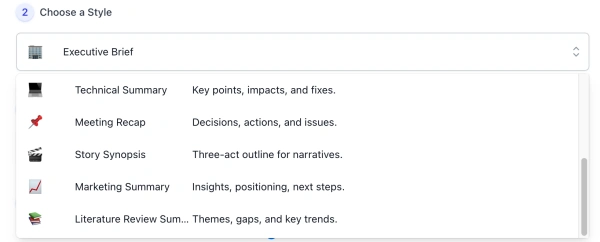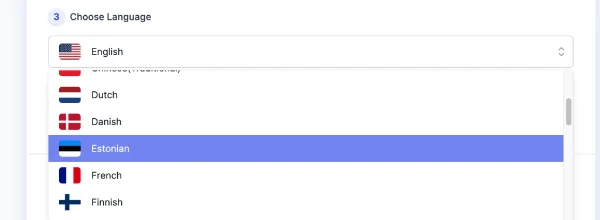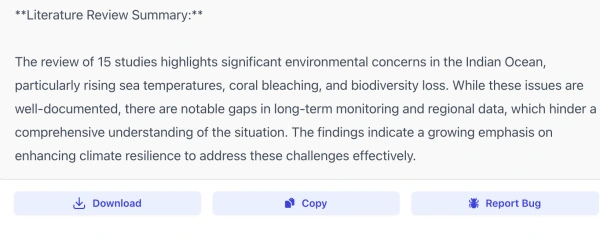Free AI Tools. No Sign-Up Required. Full Access.
AI Synopsis Generator
Free AI tool to write story synopses online — no sign-up, perfect for writers, students, and screenwriters.
Combine the current tool with these other tools to work more efficiently.
Discover other tools with functions and purposes similar to the one you are currently viewing.
- AI Summarizer Generator
- AI Description Generator

- AI Movie Description Generator

- AI Conclusion Generator

- AI MinimalAbstract Generator

- AI Book Description Generator

- AI Resume Summary Generator

- AI Meta Description Generator
- AI Sentence Shortener

- AI Script Generator

- AI Business Description Generator

- AI Writer Generator
Discover the tools most favored and highly-rated by users on our website.
Explore more AI tools in these related categories
AI Writing tools generate, or enhance text content for various writing tasks.
AI tools that automatically create text content for your images, audio, or video from user prompts.
AI tools for creating, optimizing resumes, cover letters, and other professional documents.
This is the AIFreeBox AI Synopsis Generator — an online assistant for creating structured, context-aware, multilingual synopses. More than compressing text, it helps you produce ready-to-use summaries that fit your scenario with minimal input. Available on Free and Ultra Plan.
On this page, you’ll find its capabilities, ideal use cases, step-by-step guidance, practical tips, known limitations with solutions, and FAQs — all aimed at helping you plan and produce synopses that are precise, relevant, and ready to apply.
What Can AIFreeBox Synopsis Generator Do?
AI Synopsis Generator is built on transformer-based large language models, fine-tuned for summarization across formats, audiences, and languages. It’s designed as a scenario-aware, multi-structure synopsis assistant — able to turn long-form content such as articles, reports, papers, or meeting notes into clear, structured summaries that match the intended audience and purpose.
With 10 professional styles and support for 33 languages, it adapts structure, tone, and length to fit your needs. Whether for quick daily information distillation or for professional contexts like academic abstracts, policy briefs, technical overviews, or business decision summaries, it compresses without losing factual accuracy, data integrity, or logical flow — and rewrites for clarity where needed.
This is not “automatic writing,” but a collaborative tool: you set the context, style, and language; the AI processes and shapes the synopsis, and you make the final call. The result is a concise, context-fit summary that feels ready to use.
AIFreeBox Synopsis Generator vs Generic Summary Tools
| Feature / Aspect | AI Synopsis Generator | Generic Summary Tool |
|---|---|---|
| Core Purpose | Works with you to create structured, scenario-specific synopses | Compresses text into a shorter version with no scenario focus |
| Output Structure | Adapts to 10+ professional styles with clear section logic | One-size-fits-all paragraph format |
| Language & Audience | Supports 33 languages and adapts tone for intended readers | Often single-language, fixed tone |
| Control & Customization | User selects style, tone, and length for precise fit | Limited or no control over output style |
| Collaboration Approach | Acts as an assistant, refining ideas with you | Acts as a one-off text generator |
Recommend Use Cases and Benefits
| Use Case | Core Value | Pain Point Solved |
|---|---|---|
| Executive Brief | Summarizes reports into decision-focused updates | Leaders waste time scanning long reports → get action-ready briefs in minutes |
| Academic Abstract | Produces IMRaD-structured abstracts for research | Messy or unstructured drafts → journal-compliant summaries |
| Policy Brief | Condenses evidence into clear recommendations | Scattered data → concise, decision-ready policy guidance |
| Technical Summary | Extracts key changes, impacts, and solutions | Dense specs → clear technical takeaways for engineers |
| Meeting Recap | Captures decisions, owners, and deadlines | Missed notes → shared, accountable meeting records |
| News Summary | Delivers inverted pyramid format for quick reads | Slow article reading → publish-ready news briefs |
| Lay Summary | Explains complex topics in plain language | Jargon-heavy content → accessible explanations |
| Marketing Summary | Highlights insights, proof points, and CTAs | Fragmented research → campaign-ready briefs |
| Story Synopsis | Outlines narratives in a clear three-act structure | Unfocused plots → pitch-ready story summaries |
| Literature Review | Identifies themes, gaps, and research trends | Overwhelming sources → concise, comparative synthesis |
Core value: A scenario-aware, multi-structure AI assistant that transforms long-form content into accurate, clear, length-controlled summaries in 33 languages and 10 styles — always working in collaboration with you.
How to Write a Synopsis with AIFreeBox AI:
Step-by-Step Guide

Step 1 — Provide Your Content
Paste the text you want to summarize into the input box (articles, reports, papers, meeting notes, etc.). Check the example hint below the box to align format and scope.
Step 2 — Choose a Style

Select a synopsis style from the dropdown (e.g., Executive Brief, Academic Abstract). The style controls structure and tone so the output fits your scenario.
Step 3 — Choose Language

Pick your output language. The tool supports 33 languages for cross-team and cross-market use.
Step 4 — Set Creativity Level
Use the slider to adjust phrasing: 5 for balanced/precise, 10 for more expressive rewording. For data-heavy content, a balanced level is recommended.
Step 5 — Generate and Review
Click Generate. Review the result for accuracy and fit. Use Download to save a file, or Copy to send it where you need it.
Step 6 — Report Bug: We’re Here to Help

If something looks off or breaks, click Report Bug. Your message goes to our support team—real people who monitor reports and our average first response time: under 24 hours.
Include a brief description and (if possible) the input you used; we’ll investigate and follow up to improve your experience.
Summary: Treat the AI-generated synopsis as a starting point and source of ideas—always review facts, tone, and relevance to your goal, then edit as needed to make it truly yours.
Style System Overview
The AI Synopsis Generator offers multiple styles to match different contexts and audiences. Each style defines the length, detail, and tone of your synopsis, helping you adapt to different scenarios.
- 🔍 Short — Quick and concise (50–100 words).
Best for quick overviews or short email summaries. - 📝 Medium — Balanced with key context (100–200 words).
Good for brief reports, meeting notes, or blog introductions. - 📚 Detailed — Comprehensive and in-depth (200–500 words).
Ideal for full reports, research briefs, or detailed reviews. - 💼 Executive Brief — High-level summary for decision-makers.
Perfect for business updates or policy briefings. - 🎓 Academic Abstract — Formal summary with scholarly tone.
Use for research papers, dissertations, or journal submissions. - • Bullet Points — Key ideas listed in bullet format.
Great for presentations, slides, or quick-reference sheets. - 🗣️ Plain Language — Easy-to-read, non-technical wording.
Best for public communication, training materials, or outreach.
Writing Tips for a Better Synopsis
Follow these tips to create summaries that match your real intent and fit your audience:
- Be specific with your input — Include main topic, purpose, and key data to guide the AI.
- Match style to audience — Choose styles like Executive Brief for business or Plain Language for general readers.
- Pick the right language — Select the language your audience uses; try multiple for cross-border projects.
- Adjust length to purpose — Short for quick scans, medium for balanced detail, detailed for full comprehension.
- Refine and regenerate — Edit your input or change style, then re-run to get the best fit.
Tip: Treat each output as a starting point—review and adapt it to ensure accuracy, tone, and relevance before use.
Practical Case: From Input to Final Synopsis
A real-world example showing how the AI Synopsis Generator works with you to create a precise, audience-ready summary.
User Input
- Content: 2,000-word market research report on renewable energy trends.
- Style: Executive Brief (💼)
- Language: English
AI Collaboration
The AI identifies key findings, removes non-essential details, and structures the summary according to the selected style.
Output for Review
“Renewable energy adoption grew 18% in 2024, driven by policy incentives and falling solar costs. Asia-Pacific leads in installed capacity, while Europe focuses on offshore wind projects…”
Human Refinement
The project manager adds competitor insights and adjusts phrasing for internal jargon, making the briefing team-ready.
Limitations and How to Handle Them
| Limitation / Issue | When It Happens | What to Do (Solution) |
|---|---|---|
| Missed details or nuance | Over-compression of long or dense text | Add must-keep facts at the top; choose a longer style or more detailed length to preserve nuance. |
| Inaccurate or altered phrasing | Ambiguous, incomplete, or fragmented input | Provide full context; keep key names, dates, and figures intact; use factual or academic styles to reduce rewording. |
| Tone or audience mismatch | No clear indication of who the summary is for | Select a style aligned to the audience (e.g., Lay Summary vs. Executive Brief) and mention audience in the first line. |
| Loss of data or metrics | Figures or dates scattered across the source | Group critical metrics in one place; explicitly request “include all numbers and dates” in your input. |
| Length not as expected | Preset too short for complex topics, or too long for simple ones | Switch to a different length setting; add guiding points for more detail, or request a max word count for brevity. |
| Jargon or acronyms unclear | Specialized terms without explanation | Add short definitions or expand acronyms once; pick Lay Summary for general readers or Technical Summary for experts. |
| Processing or upload errors | Large files, non-standard encoding | Split text into smaller sections; ensure UTF-8 encoding; if unresolved, click Report Bug with sample text. |
Tip: If an issue continues after these steps, use Report Bug. Our team will review your case promptly, reproduce the issue, and respond with a fix or workaround.
FAQs
Does the AI Synopsis Generator replace human judgment?
No. It provides a draft synopsis based on your input, but you should review, adjust tone, and verify facts to match your specific purpose.
How accurate is the generated synopsis?
Accuracy depends on input quality. Clear, complete, and well-structured text produces more reliable summaries. Complex or ambiguous content may need manual refinement.
Can it handle very long documents?
Yes, but very large files may require splitting into smaller sections. This ensures the AI captures all key points without omitting details.
Will it preserve technical terms and data?
Yes, if they are clearly presented in the input. For critical metrics or jargon, add a note to “retain all terms and figures” to avoid loss.
What happens if the output tone is not right?
You can regenerate the synopsis with a different style or give clearer tone instructions. Mention your audience explicitly for better alignment.
How does the “Report Bug” feature work?
If you encounter errors or unexpected results, click “Report Bug” and include your text sample. Our support team will investigate and reply with a fix or workaround.
Does it support multiple languages?
Yes. It supports 33 languages, but you should still check for cultural nuances or idiomatic expressions that may require human adjustment.
Creator’s Note
When I built the AI Synopsis Generator, my goal was not to replace the way people read, think, or write — but to make those processes more efficient and focused.
Summarizing is more than shrinking words; it’s about understanding structure, context, and audience, then expressing the essence with clarity.
The AI is here as a collaborator. It can quickly condense complex material, suggest structure, and adapt tone or length — but the final judgment, the subtle nuance, and the responsibility for accuracy remain with you.
Good summaries come from this partnership: your direction and insight, supported by the model’s speed and adaptability.
2025-10-23
🎞️ Try it out now — free, online, and ready when you are.
Turn complex plots into clear synopses — let AI help you summarize stories with structure, flow, and creativity.